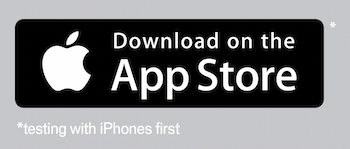Managing Expectations

We’re being careful to say “test” our app instead of “download” our app.
We’ve talked a lot about how user expectations helped shape our implementation. There are times when it’s incredibly valuable to listen to your users, but there is also a time when you need to manage those expectations, too. As we got closer to launching the project more fully onto the floor, it became clear to us that if we were considering this an iterative project we needed to start doing a better job of communicating that to our users.
One thing that we’ve looked at is our language; how are we positioning the app to our audience? In early drafts, we were using a lot of wording that everyone uses. Things like “download our app” and “use our app to ask us questions” were commonplace. We started a significant shift to always say “try our app” and “test our app.” Also, when speaking about the app on the floor, we want to introduce the idea that we are in early stages and “your feedback will help us shape our app.” This was surprisingly easy to do once we started to view our messaging through a testing lens.

Testing with iPhones first hinting at more to come.
On large signage, you’ll also find that we are including language that acknowledges we’re deploying on iPhones first. That was a clear path after seeing that 83% of our smartphone carrying visitors were on the iPhone; in an iterative process, we wanted to start simply by releasing and perfecting on one device before we move on to others. However, we’ve still got many visitors on other platforms and we need to manage the expectation that while we may be releasing on the iPhone first, we’re thinking about all of our users. (In the meantime, anyone can ask a question using our iPad kiosks located in select galleries throughout the institution.)

The app store icon that was not to be had.
It’s interesting that the one idea we had, which would have been the most clear to users, couldn’t be done. We wanted to put a “beta” ribbon over our app icon, so at the point of use it was reinforced that we were in testing. Know what? Apple has a rule where you can’t have anything “beta” in the store, so this was a no go.
Starting tomorrow our project will hit the floor for our soft launch. At every turn, we ask ourselves how we can impart to users that this incredibly iterative program is in its very earliest of days.

Shelley Bernstein is the former Vice Director of Digital Engagement & Technology at the Brooklyn Museum where she spearheaded digital projects with public participation at their center. In the most recent example—ASK Brooklyn Museum—visitors ask questions using their mobile devices and experts answer in real time. She organized three award-winning projects—Click! A Crowd-Curated Exhibition, Split Second: Indian Paintings, GO: a community-curated open studio project—which enabled the public to participate in the exhibition process.
Shelley was named one of the 40 Under 40 in Crain's New York Business and her work on the Museum's digital strategy has been featured in the New York Times.
In 2016, Shelley joined the staff at the Barnes Foundation as the Deputy Director of Digital Initiatives and Chief Experience Officer.


Start the conversation